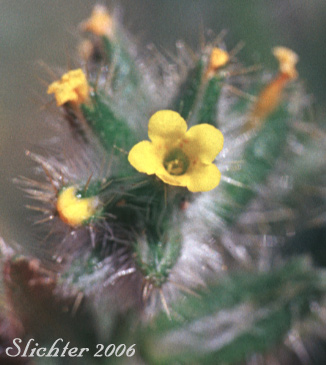 The
photo at right shows a close-up of the flower of Menzies fiddleneck as seen along
the Domingo Pass Road in the Pueblo Mts of southeastern Oregon.........June
19, 2004. Note the lack of hairs covering the throat of the flower.
The
photo at right shows a close-up of the flower of Menzies fiddleneck as seen along
the Domingo Pass Road in the Pueblo Mts of southeastern Oregon.........June
19, 2004. Note the lack of hairs covering the throat of the flower.
Menzies' fiddleneck is a colorful annual and weed-like wildflower of the intermountain west. Plants have erect, simple to few-branched stems from 15- 70 cm high. The stems are covered with long, spreading, stiff hairs and generally lack the undercoat of shorter, softer hairs that point downwards as seen on other Northwest fiddlenecks, although the smaller hairs may be found in the inflorescence. The leaves are linear to linear-oblong or ovate in shape, measuring up to 12 cm long and up to 2 cm wide. The basal leaves are lacking or few, not forming a basal tuft. The stem leaves are more widely spaced and are reduced in size upwards.
The inflorescence consist of scorpioid spikes which unoil and elongate with age. The 5 sepals are separate (not fused) and relativley the same size and shape. They measure up to 10 mm long in fruit and are covered with numerous spreading to ascending hairs. The corollas are light yellow to occasionally light orange in color and have short tubes up to 7mm long or not much exserted past the tips of the sepals. The corolla lobes are spreading to ascending and measure 1-3 mm long.
See also: Rigid Fiddleneck: Amsinckia retrorsa
variety intermedia - Flowers more orange and larger, measuring over 7 mm long and 4 mm wide. Generally found from south-central and south-eastern Oregon and south to Nevada and California.
variety menziesii - Flowers more yellow and smaller, generally measuring less than 7 mm long and 3 mm wide. More frequently found in the northern half of the range of the species, but will overlap the range of variety intermedia in southeastern Oregon.
Menzies' fiddleneck is a species of open, dry places such as fields and roadsides. It can occasionally be found on moister sites.
Menzies' fiddleneck may be found across the Pacific Northwest on both sides of the Cascade Crest from southern British Columbia south to California and Nevada and eastward to Idaho. It occasionally may be found as far north as Alaska and the southern Yukon.